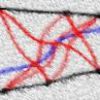 39
39Let the limit be some value L. Take logarithm on both sides,
Limn→∞ [nlog(x) - log(n!)] = logL
This is the natural logarithm. For log(n!), we use Stirling's formula -:
log(n!) = nlog(n) - n + more terms which can be neglected.
Limn→∞ [nlog(x) - nlog(n) + n] = logL
Now you can see that the LHS will always be infinity whatever be the value of x.
logL = ∞, this happens when L = 0.
Hence the limit is 0.
Maybe his higher level concept involved gamma functions...
 11
11wow....gr8 solution...
Thanks Pritish..
 21
21@ pritish ur sayin log0 =∞
but then 0= e∞= ∞......???
 341
341There are two ways to look at it
1) By the archimedean property of real numbers there exists a natural number N such that N>x (i took the liberty of using this concept as u said u r in engg. otherwise you say its just plain common sense :D)
Let K=\frac{x^N}{N!}
and let L = \frac{x}{N+1}<1
Then
0< \frac{x^n}{n!} < K L^{n-N} = \left(\frac{K}{L^N}\right) L^n
and since \left(\frac{K}{L^N}\right)\lim_{n \rightarrow \infty} L^n = 0 by sandwich theorem the required limit is zero.
2) We know that if the infinite series tex]\sum_{n=1}^{\infty}a_n is convergent then \lim_{n\rightarrow \infty}a_n=0
This follows from the Cauchy criterion on the series a_1, a_1+a_2, a_1+a_2+a_3,..., a_1+a_2+...+a_n,...
Since e^x = \sum_{n=0}^{\infty} \frac{x^n}{n!} is convergent we must have \lim_{n \rightarrow \infty} \frac{x^n}{n!} = 0
 11
11sir i did not understand how this came..
0< \frac{x^n}{n!} < K L^{n-N} = \left(\frac{K}{L^N}\right) L^n....
sir i cud'nt understand how are we getting xnn! < K Ln-N ???
 341
341\frac{x^n}{n!} = \frac{x^N}{N!} \times \frac{x}{N+1} \times \frac{x}{N+2}\times...\times \frac{x^n}{n}
Now its obvious that \frac{x}{N+k} < \frac{x}{N+1} for k>1.
Hence
RHS<K \left(\frac{x}{N+1}\right)^{n-N} = KL^{n-N}
 39
39There was bound to be something wrong with my solution :P
 11
11Yes now I understood it...Thank you sir...
 21
21somebody check if my solution is correct....
L=lim n→∞ (xn / n! )
log L =nlog x - log n!= nlog x-log(n/e)n - log√(2 pi n)
=nlog(xe/n) - log √(2 pi n)
so log L = -∞ L=0
 341
341That's a clean solution using Stirling Approximation for n!
The proof in my post gives a sense of numerically why it should go to zero. Also, if you write out the sequence, it goes on increasing for a while and then begins to drop off. So its a good illustration that for the limit of a sequence, the behaviour up to a countable (perhaps infinite) number of elements may be ignored - its the behaviour that takes place eventually that counts.
If you guys have the time, it may be worth your while to read about Goodstein sequences that all counter-intuitively converge to zero. The first few terms rapidly increase to some astronomical magnitude and then astonishingly decrease to zero. Isnt that fantastic!